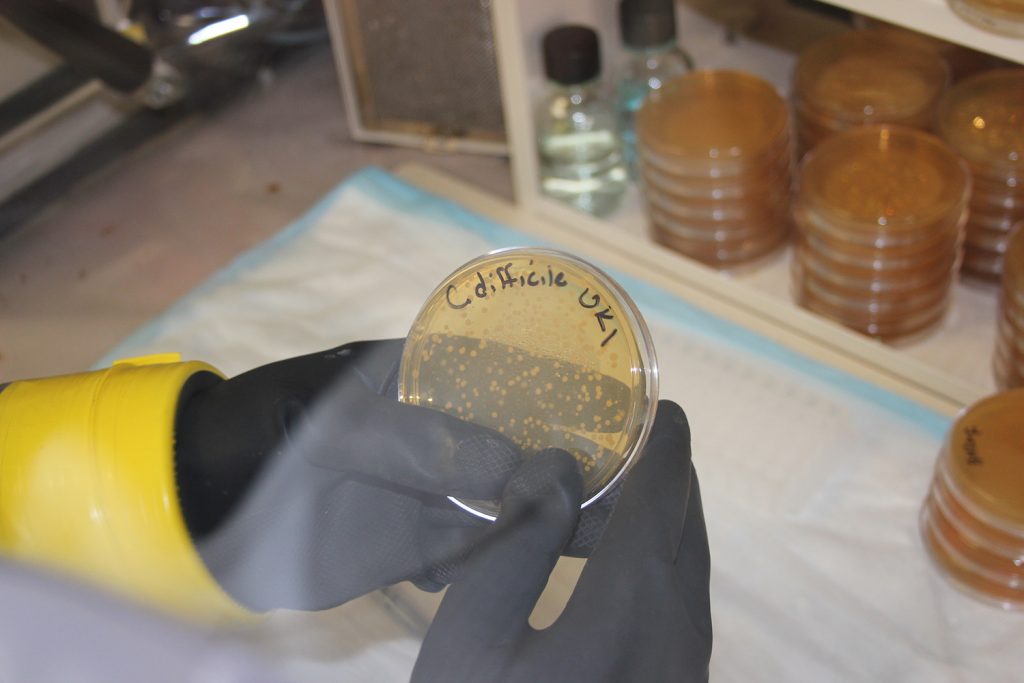C. difficile: Treatments should focus on starving superbug, new study says

Scientists around the world have been working in earnest to improve understanding of an increasingly virulent superbug, Clostridium difficile. The highly contagious hospital-acquired pathogen designated by the Centers for Disease Control and Prevention as one of its five most urgent threats to the U.S. healthcare system causes more than 500,000 infections and 29,000 deaths each year at a total societal cost exceeding $5 billion.
Taking a page from Benjamin Franklin and his “ounce of prevention worth a pound of cure” approach, biologists at Texas A&M University and Baylor College of Medicine have teamed up in a novel National Institutes of Health-funded systems biology study aimed at tackling the problem at its source — the initial point of infection — in hopes of pinpointing what makes patients susceptible to it in the first place.
Prior studies have shown C. difficile infection to be strongly correlated with a high abundance of secondary bile acids that are toxic to C. difficile in laboratory settings. These small molecules are generated by a healthy gut microbiome from primary bile acids that are synthesized in the liver.
Texas A&M biologist and 2020 Chancellor’s EDGES Fellow Joseph Sorg says scientists have long viewed these small molecules as a key protector in preventing C. difficile infection. However, based on his team’s results published earlier this fall in the journal PLOS Pathogens, he recommends shifting that spotlight toward a new target — the microbes that compete with C. difficile for the nutrients which fuel the deadly bacterium’s growth.
“Many ongoing efforts are developing probiotic treatment options for C. diff-infected patients — efforts that focus on restoring secondary bile acids to patients,” Sorg said. “Our findings show that these treatments should instead focus on microbes that consume nutrients important for C. diff growth and that secondary bile acids are a red herring for protection.”
Sorg says the team’s research, which featured 2016 Texas A&M microbiology graduate and current Sorg Laboratory graduate student Andrea Martinez Aguirre as a first author on the resulting paper and members of Tor Savidge’s group at Baylor College of Medicine, has field-changing scope because it fundamentally affects how scientists look at how C. difficile colonizes its potential hosts. Moreover, it defies decades of dogma that by default credits secondary bile acids as the catalyst for protecting susceptible patients from C. difficile infection in yet another cautionary correlation-without-causation tale.
“The fact that secondary bile acids are enriched in a C. diff-resistant environment is interesting, but this is only correlative,” Sorg said. “Therefore, we sought to test if this truly was the mechanism of protection.”
As the basis of their study, the team used mice derived germ-free at Baylor College of Medicine that were colonized with a single species of bacteria known to be involved in secondary bile acid generation and strongly correlated with a protective C. difficile environment. As an additional control measure, they selected a mutant mouse strain purchased through the NIH’s Knockout Mouse Project that was bred at Texas A&M and distinct for its inability to synthesize a major class of bile acids, thereby further limiting the secondary bile acid pool.
“Surprisingly, we found that mice colonized with these microbes (C. scindens, C. hiranonis, or C. leptum) protected against C. diff disease but did not produce secondary bile acids,” Sorg said. “Then, using untargeted metabolomics, we found that these bacteria were depleting nutrients in the gastrointestinal tract that are required for C. diff metabolism — specifically proline and glycine. C. diff and related organisms use these amino acids to fuel a particular type of metabolism, Stickland metabolism. We went on to show that other microbes that use this metabolism but that cannot generate secondary bile acids protect against C. diff disease, while microbes which cannot do this metabolism do not protect.”

